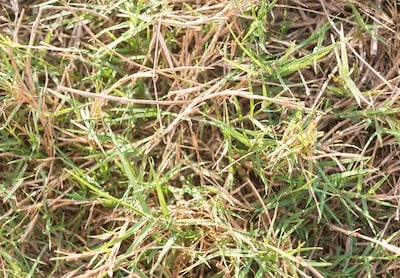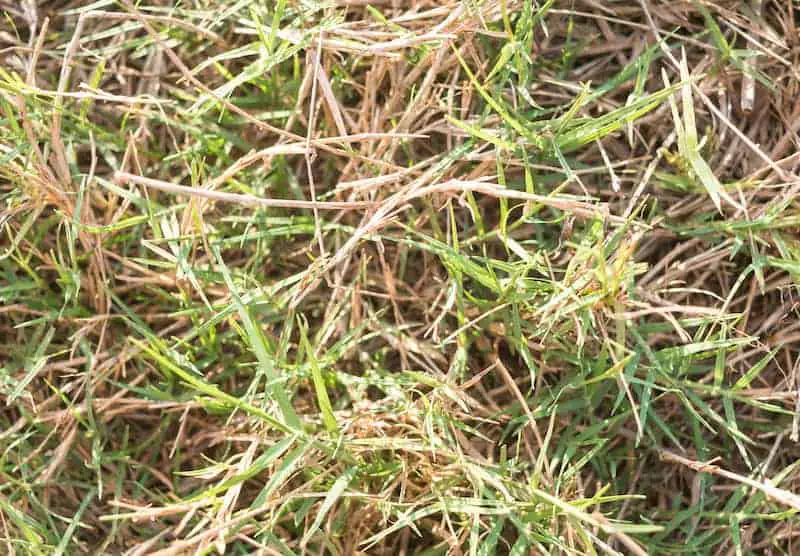How to Treat Grass With Red Tips
While a nice plush lawn is the goal of every homeowner, unfortunately, it can be hard to achieve. Things like dry grass, overwatering, grass with white tips, and even mysterious red tips can cause serious yardwork woes. Fortunately, there are often easy solutions to common problems such as red tips on your grass.
Why does my grass have red tips? The most likely cause of grass with red tips is a disease called red thread. This disease is caused by a fungus called Laetisaria Fuciformis and is caused in part by ill-nourished grass. This type of disease can be treated effectively using a fungicide formulated for similar issues.
Grass with red thread has reddish-pink, spikey threads on the tips of the blades. The blades may even have small, thin strands flying around them. How can you treat and prevent red thread from taking over your yard? Read on to learn how to identify red thread disease, treat it and prevent it to keep your yard lush and green.
Identifying Red Thread Disease
You will usually start seeing red thread in the springtime. In the Pacific Northwest, you often see it well into winter due to the mild and wet climate in that part of the United States. If you’ve seen prolonged periods of wet and overcast weather, you will see an influx of red thread in your lawn unless pre-emptive measures are taken to prevent its spread. So, how do you identify red thread on your lawn?
If your grass is wet, you will notice a darker red color. A pink color is present when the grass is dry. If you are checking to see if red thread is present in your lawn, check for the red color after you have watered the lawn or in the morning when dew is present.
There are some things other than color that you can check for to make sure you are dealing with red thread. The blades of grass will look ragged compared to healthy grass. They will often look like they are dry and dying. Usually, the blades of grass will have an irregular shape to them.
You don’t often see the thread-like strands until the later stages of the disease. The grass will start to exhibit brittle, antler-like strands extending to the grass leaf tips. As red thread disease progresses, you may also see a pink growth on top of the grass blades.
Understanding What Causes Red Thread Disease
Red thread is caused by the fungus Laetisaria Fuciformis. Not properly nourishing your yard makes the blades weaker and more susceptible to getting the disease. Certain types of grass have higher levels of red thread disease seen in them. Not sure what type of grass you have in your yard? Let’s take a closer look at the types of grass more susceptible to red thread disease.
Bentgrass
Bentgrass is the dense, fluffy grass you often see on golf courses in the Northern United States. Due to the costs of maintaining a lawn full of bentgrass, it normally isn’t seen in residential yards
Bermudagrass
Similar to bentgrass, Bermuda grass is mainly used on golf courses in the Southern United States. Like bentgrass, it is very expensive to maintain and isn’t widely used in home lawns.
Fescues
Homes in the Northern United States often use fescues (both tall and fine) as grass, as they are very tolerant of shade, foot traffic, cold, and drought.
Perennial Ryegrass
The last type of grass that you often see red thread disease in is perennial ryegrass. Ryegrass grows best in temperate or hot and humid weather conditions. It cannot handle extreme cold or drought but is great for areas with heavy foot traffic.
If you continue to struggle with recurring red thread disease in your yard, you may wish to consider replanting with one of the many red thread-resistant grasses.
Treating Red Thread Disease
 To control the spread of red thread disease and get your lawn looking beautiful and lush again, you’ll have to treat it with a fungicide. There are several fungicides on the market that prevent the spread of the disease for up to four weeks. You will need to choose a broad-spectrum fungicide that will kill the existing fungus while preventing the spread of red thread disease to other parts of the lawn.
To control the spread of red thread disease and get your lawn looking beautiful and lush again, you’ll have to treat it with a fungicide. There are several fungicides on the market that prevent the spread of the disease for up to four weeks. You will need to choose a broad-spectrum fungicide that will kill the existing fungus while preventing the spread of red thread disease to other parts of the lawn.
If you can, use the fungicide product when the temperature outside is between 60 and 75 degrees F. Most lawn diseases are going to leave some damaged areas behind and red thread disease is no exception. If you have treated your lawn with fungicide and still have some damaged areas, you will likely need to patch them. Once you have the disease under control and stop seeing red tips on the blades of grass, you can reseed the damaged areas.
With the right care, you’ll make it harder for red thread to move in and affect your lawn.
Preventing Red Thread Disease
So how did your lawn get red thread disease in the first place? You likely weren’t practicing basic lawn care, leaving it undernourished and susceptible to red thread and several other grass diseases.
Preventing red thread and other lawn diseases is simple if you take good care of the turf. Regularly feeding your lawn, watering it properly, mowing it routinely, and aerating it every few years is an important part of having a lush and disease-free lawn. Another thing to think about is overseeding your lawn each year. If your lawn is 10 years or older, you should definitely look into doing this.
Feeding Your Lawn
All lawns need fertilizer in early spring when the grass begins to green up. Your fertilization schedule for the rest of the season depends on the type of grass in your lawn, the type of fertilizer you use, and your climate. Most lawn seed is a mixture of several different types of grasses, so both spring and fall fertilization are appropriate. There are tons of lawn fertilizers on the market, so do you research when choosing the best one for your type of grass.
Watering Your Lawn
It goes without saying that water is important for keeping your lawn healthy. But how do you water it properly? Choosing the time of day is very important. Do not water at night, as that is the perfect time for diseases to pop up. If you water at midday when it’s hot outside, most of the water will evaporate. Mid-morning is an excellent time to turn the sprinklers on.
Make sure you are allotting the correct amount of water to your lawn, as well. If you water too lightly, the grassroots will not grow deep enough. When hot weather comes around, it could kill the grass.
Mowing Your Lawn
There’s a lot more to mowing your lawn than just pressing start on the mower. To get the most out of your lawn and keep it free of disease, you want to follow some simple tips and tricks.
Longer grass blades can develop a deeper root system to help get water and nutrients into the mower, so set your mower at the highest preferred setting for your grass type and only cut the top 1/3 of the grass blades at any one time.
You also want to be sure to mow your lawn when it’s dry, preferably in the early evening. It’s important to vary your pattern and schedule for mowing. You don’t want your grass to grow in one direction, nor do you want to cut it when it’s not ready. It is never ideal to mow the lawn in the rain.
An easy and free way to fertilize your lawn is with the lawn clippings that show up after you mow. Grass clippings break down quickly and return beneficial nutrients to the soil. Piles of long clippings don’t break down quickly and can smother growing grass, so mow often enough that you can keep the clippings small.
It’s important to sharpen mower blades at the first sign of wear. Dull blades tear up grass, causing ragged, brown edges. You don’t want brown edges on top of the red tips from red thread disease that you’re trying to prevent. Using a dull mower blade causes your grass to weaken over time, making it more susceptible to disease like red thread. Give your mower a tune-up and blade sharpening once a year to make sure it’s in great working condition.
Aerating Your Lawn
You might be doing a great job feeding, watering, and mowing, but if your lawn doesn’t seem to be growing as well as it should, it may be because of compacted soil. The grass is suffering because air, water, and nutrients aren’t able to move freely into and through the soil and getting to the roots.
Want to know how to tell if your soil is overly compacted? Just stick a screwdriver in it. If it can’t go in easily, it needs to be aerated.
Lawn aeration, coring, and aerifying are different terms you might hear for the same procedure. A core aerator removes plugs of soil from your lawn to loosen compacted soil and allow vital air, water, and nutrients to reach the roots. If you plan to DIY, rent an aerator. Alternatively, contact a lawn care or Tulsa pest control service to aerate your lawn for you.
Early spring or fall is the best time to aerate your lawn for cool-season grasses, while spring through early summer is the best time for warm-season grasses. For grass that grows in sandy soil or a healthy lawn, aerating the lawn can happen every 2-3 years. If your lawn isn’t looking so great or your soil has clay in it, you need to look into aerating it every year. If your lawn is 10 years old or older, you should look into overseeding it each year with high-quality grass seed.
Following all of these steps will ensure you have a lush, healthy lawn free of diseases like red thread disease and the nasty red tips it brings with it.

